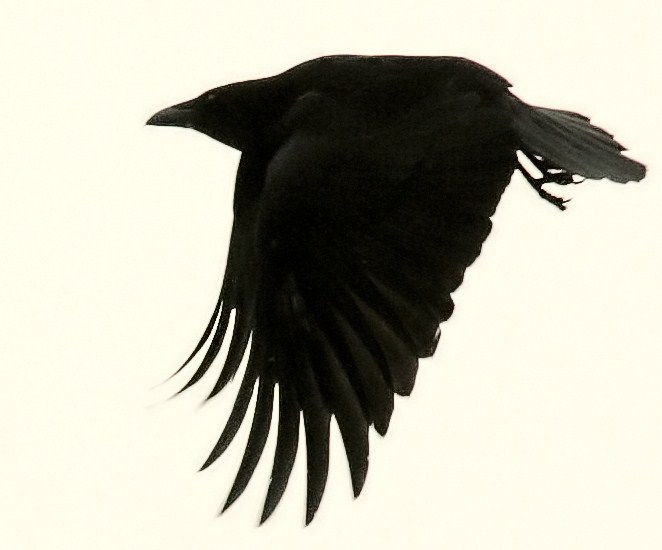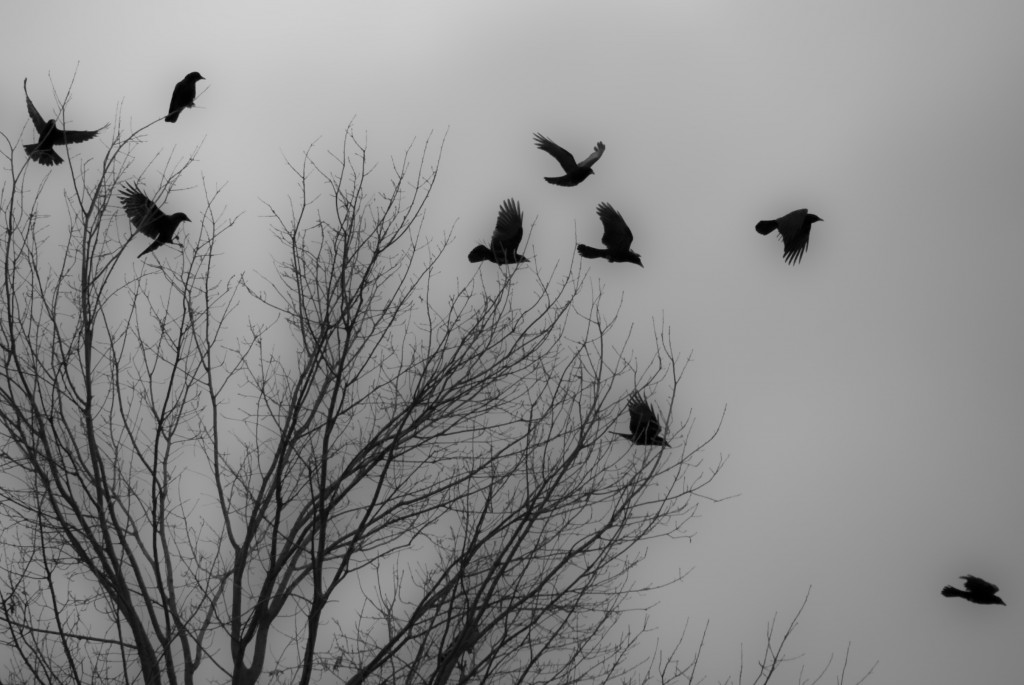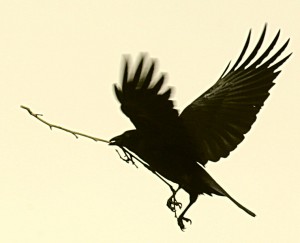 “Light thickens, and the crow makes wing to the rooky wood.” MacBeth is talking, telling his wife it’s a good night to murder the king. Even a century earlier, the collective noun was “a murder of crows.” Three centuries later, a poet watches a horse that’s been shot: “gorged crows rise ragged in the wind. The day/ After death I had gone for farewell, and the eyes/ Were already gone – that/ the beneficent work of crows.” A year ago I watched a crow kill and eat a nestling robin. Nobody likes crows. I think it’s because they’re so black – black feathers, black legs, black bills, black eyes. They look like flying shreds of a medieval hell.
“Light thickens, and the crow makes wing to the rooky wood.” MacBeth is talking, telling his wife it’s a good night to murder the king. Even a century earlier, the collective noun was “a murder of crows.” Three centuries later, a poet watches a horse that’s been shot: “gorged crows rise ragged in the wind. The day/ After death I had gone for farewell, and the eyes/ Were already gone – that/ the beneficent work of crows.” A year ago I watched a crow kill and eat a nestling robin. Nobody likes crows. I think it’s because they’re so black – black feathers, black legs, black bills, black eyes. They look like flying shreds of a medieval hell.
 Well, ok, it’s all true. Then my friend Nell did a radio story on how West Nile virus was so hard on crows because they live in families whose members were dying. So I looked up crows. NPR and PBS have minor fixations on them. Citizen science has projects on them. I have undergone crow revisionism and here’s my argument.
Well, ok, it’s all true. Then my friend Nell did a radio story on how West Nile virus was so hard on crows because they live in families whose members were dying. So I looked up crows. NPR and PBS have minor fixations on them. Citizen science has projects on them. I have undergone crow revisionism and here’s my argument.
Crows mate for life, have one brood a year, and the siblings help raise the crowlets. If a spouse dies, a nephew or niece helps out. During the spring mating season, the families live separately; but during fall and winter, the families all roost together. They begin congregating in the early evenings, pick a staging area, shift areas, and join other families, their numbers increasing logarithmically, hundreds and thousands of them, flying like a blizzard, and says a researcher, great confusion is evident. They somehow converge into a single roost, talking continually on into the night. The noise they make is three-dimensional.
Nobody knows why they do this: maybe they’re warmer this way, maybe it’s defense against predators like hawks and owls, maybe they can gang up on the hawks and owls, maybe they tell each other where the food is.
 For some reason, crows’ social sense extends to us. They recognize individual people. If you feed them, they wait for you and for no other person; they follow you down the street; they follow your car; they follow your car if you’re across town; they tell their friends about you and pretty soon, you’re followed by a gang of crows. If you take young crows out of nests to band them, the crows hate you. “Whenever they notice me in their territory,” says a crow researcher who bands young crows, “they will come over and yell at me. They will follow me around and keep yelling for as long as I am there.”
For some reason, crows’ social sense extends to us. They recognize individual people. If you feed them, they wait for you and for no other person; they follow you down the street; they follow your car; they follow your car if you’re across town; they tell their friends about you and pretty soon, you’re followed by a gang of crows. If you take young crows out of nests to band them, the crows hate you. “Whenever they notice me in their territory,” says a crow researcher who bands young crows, “they will come over and yell at me. They will follow me around and keep yelling for as long as I am there.”
So to cap my argument, another poem, this one about farmers shooting crows: “they ran out of shells before they ran out of crows/ and the crows came back and walked around the pellets and/stuck out their tongues/ and mourned their dead and elected new leaders/ and then all at once flew home to fuck to fill the gap.”
___________
Credits: first poem – Robert Penn Warren, “Dead Horse in Field;” second poem – Charles Bukowski, “the weather is hot on the back of my watch“; first & fourth photos – Dr. Pat; second photo – Will Montague; third photo – Daniel Ripoll
Beautiful photos. I live in suburban Chicago. The cawing of crows in my backyard used to be irritating. Then West Nile wiped them out. Now it is eerily quiet.
Oh, I don’t want to think that. Are you sure they’re not around because they’re just off on a mating season toot? Probably not. I’m sorry.
I’ve always loved crows – their intelligence amazes me.
I didn’t write about their intelligence, but yes, they’re very. They use tools inventively. I suspect it’s all related to their ability to recognize individuals.
Do you know the difference between rooks and crows? “If you see a crowd of rooks, they’re crows. If you see one crow, it’s a rook.”
Oh excellent, Tim! I don’t think we have rooks in the US, do you? Don’t they just live across the ocean?
Hmmn. Interesting one. When I blogged about it last year at http://timbobig.blogspot.com/search?q=rooks
I had them the other way round – rooks were the gregarious ones, crows the solitaries. My (British) English dictionary bears this out, though they seem to be the same species, with different behaviours.
Divided by a common language?
Confusing the issue: http://www.timesonline.co.uk/tol/life_and_style/court_and_social/article4759953.ece
American crows are definitely gregarious but apparently not during the spring mating season. Maybe everybody’s mother said that about solitary crows just in the springtime. Or maybe British crows and American crows have different live styles. I wouldn’t want to think all those mothers were wrong.
I will never look at a crow in the same way again!
That’s weird, I don’t think I have ever seen a crow in Spain…
Wish they had the magpie call’s. Noisy bunch
Last year I left my lunch in a plastic bag outside the Kimberley BC ski hut. A crow tore open bag and opened a small plastic food container with four strong plastic clips holding down the sealed lid. It ate the salmon contents, but sampled and rejected the accompanying vinegar plastic sachet and similarily rejected the bananna.It ate the apple.
Next day it was waiting in the same place for more.
Invoking Edgar Allan Poe, I skied past and called out to it, “Quoth the human, never more”. I think it understood.
Still more on crows, Ann above refers to them “inventively using tools”.
To elaborate an example, they’ll choose a small twig and poke it into small holes (such as woodpecker holes) in the trunk of a tree fishing for grubs inside. The grub grabs the wriggling twig and get pulled out and devoured. Wish I’d thought of that.
Here’s one of lots of videos — I think it’s the funniest. The crow is so matter-of-fact about the whole thing.
http://www.youtube.com/watch?v=TtmLVP0HvDg
The coolest story I’ve heard of crow intelligence was them being observed cracking hard nuts by dropping them in a crosswalk zone. Cars would drive over the nuts exposing the nutty innards and when the light flipped for the crosswalk crows would waltz out into stopped traffic to collect their meal. Simply amazing.
I’ve heard the same sort of thing. But then I’ve also seen seagulls dropping clams (or something) on pavements, then swooping down and scooping up whatever was left. Though having cars drive over your dinner does seem more intelligent than just dropping it on the street. Yours in crow supremacy.
“The noise they make is three-dimensional.”
Oh, good.
Because I just can’t take two-dimensional noises.
Especially logarithmically increasing ones.
Nah, but words make pretty sounds, I know.
Well, ok, you’re right. Noise is three-dimensional, just is. But I didn’t know how else to describe that feeling that the noise isn’t coming from one direction, it’s surrounding you.
Not only to figure out that cars can crush nuts that are too hard for their beak but to fully understand how a crosswalk works and learning to exploit that small window of opportunity just blows my mind.
Great post, btw. Blog Bookmark’d.
Had to share… This weekend’s full moon is sometimes called the “Crow Moon”. Northern Native American tribes refer to the last full moon before vernal equinox as the Crow Moon because of the cawing of crows signals the end of winter. This Saturday is also a supermoon. http://earthsky.org/tonight/high-tide-alert-closest-full-moon-of-2011-on-march-19
How nice to hear from you, Ms. Janie. I love that about the Crow Moon. This weekend, I’ll caw at it.
I moved in December, and crows live in the woods behind my condo. I’ve been taking pictures of crows since February, both at home and when I’m on photo walks. I usually catch them in silhouette. Here’s the link to my Crow set on Flickr: http://flic.kr/s/aHsjtDTuxu
Nice pictures, Fred. Crows seems to be photogenic, don’t they.